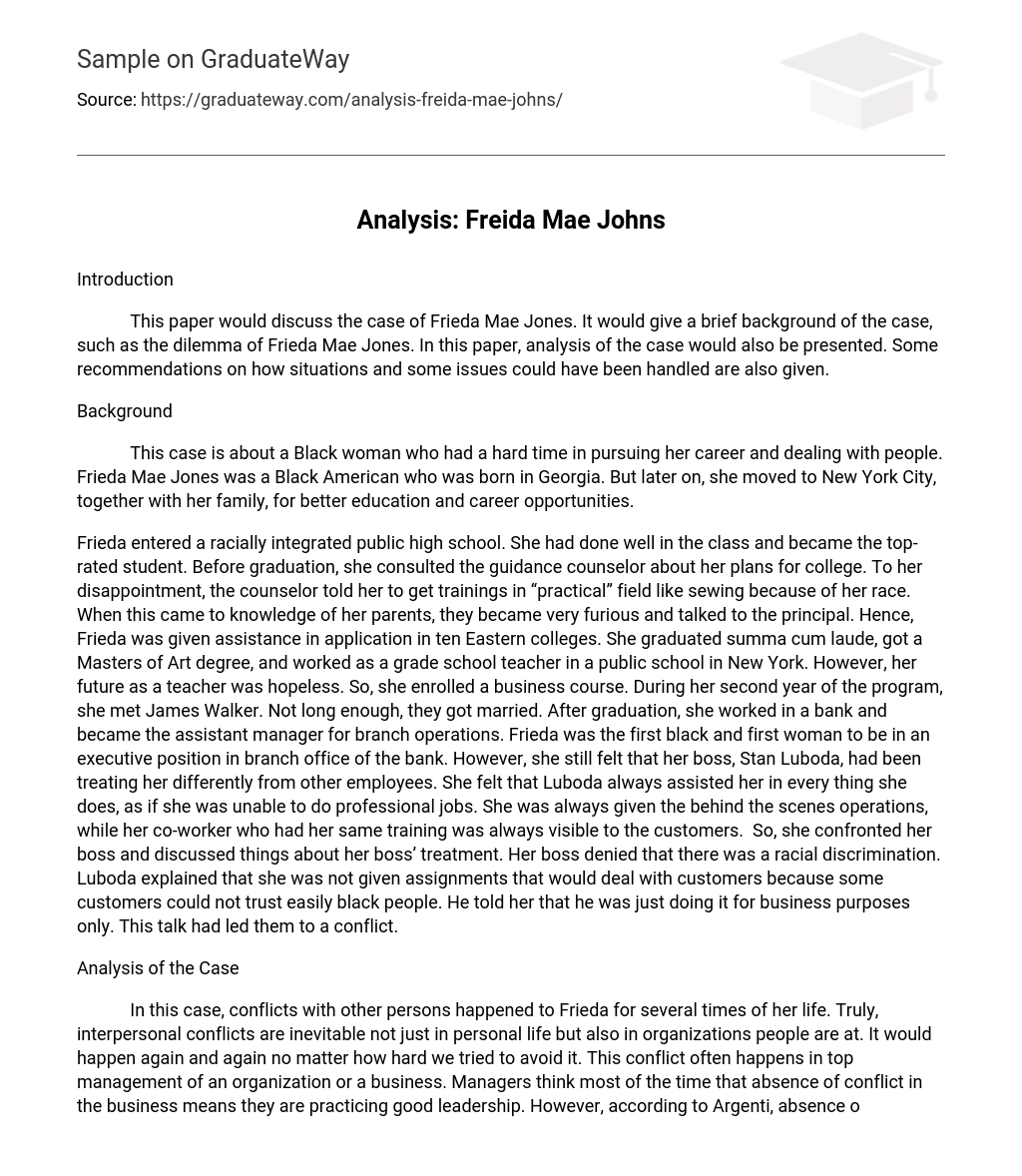Introduction
This paper would discuss the case of Frieda Mae Jones. It would give a brief background of the case, such as the dilemma of Frieda Mae Jones. In this paper, analysis of the case would also be presented. Some recommendations on how situations and some issues could have been handled are also given.
Background
This case is about a Black woman who had a hard time in pursuing her career and dealing with people. Frieda Mae Jones was a Black American who was born in Georgia. But later on, she moved to New York City, together with her family, for better education and career opportunities.
Frieda entered a racially integrated public high school. She had done well in the class and became the top-rated student. Before graduation, she consulted the guidance counselor about her plans for college. To her disappointment, the counselor told her to get trainings in “practical” field like sewing because of her race. When this came to knowledge of her parents, they became very furious and talked to the principal. Hence, Frieda was given assistance in application in ten Eastern colleges. She graduated summa cum laude, got a Masters of Art degree, and worked as a grade school teacher in a public school in New York. However, her future as a teacher was hopeless. So, she enrolled a business course. During her second year of the program, she met James Walker. Not long enough, they got married. After graduation, she worked in a bank and became the assistant manager for branch operations. Frieda was the first black and first woman to be in an executive position in branch office of the bank. However, she still felt that her boss, Stan Luboda, had been treating her differently from other employees. She felt that Luboda always assisted her in every thing she does, as if she was unable to do professional jobs. She was always given the behind the scenes operations, while her co-worker who had her same training was always visible to the customers. So, she confronted her boss and discussed things about her boss’ treatment. Her boss denied that there was a racial discrimination. Luboda explained that she was not given assignments that would deal with customers because some customers could not trust easily black people. He told her that he was just doing it for business purposes only. This talk had led them to a conflict.
Analysis of the Case
In this case, conflicts with other persons happened to Frieda for several times of her life. Truly, interpersonal conflicts are inevitable not just in personal life but also in organizations people are at. It would happen again and again no matter how hard we tried to avoid it. This conflict often happens in top management of an organization or a business. Managers think most of the time that absence of conflict in the business means they are practicing good leadership. However, according to Argenti, absence of conflict is an indicator of “being out of touch with significant changes in the marketplace”. Conflict predicts the organization’s success. It is because interpersonal conflict is the most difficult test to the skills of managers. Therefore, interpersonal conflict in this case is viewed positively.
Furthermore, it is important for the management to identify the type of conflict or its focus. Eisenhardt gave two categories of conflict: people-focused and issue-focused. People-focused conflict deals more with personal feelings like demands for justice and presence of resentment. It is about moral indignation, and often, the emotional level is high. Issue-focused conflict, on the other hand, is about rational negotiations. It is more about the decision-makings that involve interests of different departments, projects, or functions. In this case, the conflict is people-focused because it deals with feelings of Frieda. (“Managing Conflicts”)
Kathy Eisenhardt, together with her colleagues, challenges the management to have an argument sometimes without sacrificing their teamwork or their ability to function as one team. In their one review, they gave organizations some keys in handling conflicts effectively (“Managing Conflicts”):
1. Work with more, rather than less, information
2. Focus on the facts.
3. Develop multiple alternatives to enrich the level of debate.
4. Share commonly agreed-upon goals
5. Inject humor into the decision process.
6. Resolve issues without forcing consensus.
7. Maintain a balanced power structure.
Another approach that Stan Luboda could do about the dilemma with Frieda is the compromising response. With this approach, both sides are asked to sacrifice something for a common gain. Through this, satisfaction to both sides can be provided. (“Managing Conflicts”)
Conclusion
The case of Frieda Mae Jones is not new in businesses. Interpersonal conflicts often happen for whatever reasons. It is only important for the management to know how to handle conflicts effectively. This is possible when the management can identify the type of conflict and the approaches to be done. Looking at the bright side of things, conflicts are not really bad. In fact, they help the organization and its people to grow.
Reference:
Managing conflicts. Retrieved January 4, 2007 from http://cte.rockhurst.edu/FileUploads/Whetten_CH07.pdf





